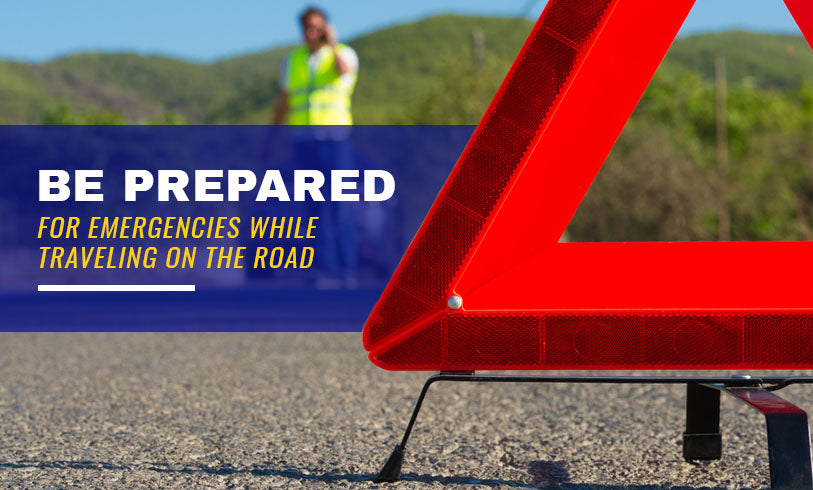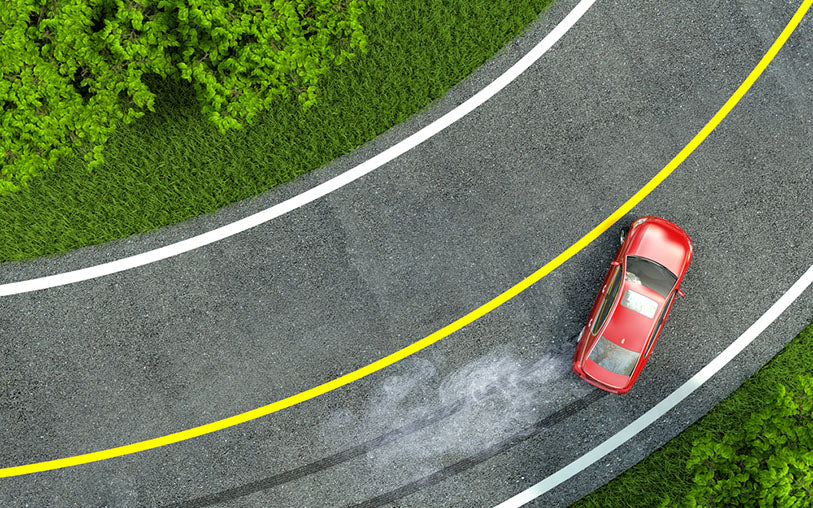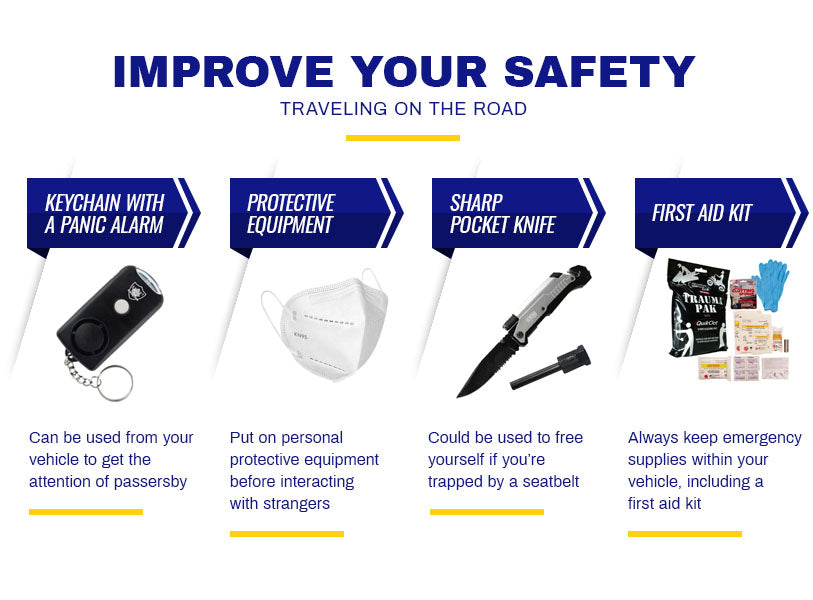Be Prepared for Emergencies While Traveling on the Road

In the United States, the average American spends 8 hours and 22 minutes a week in their vehicle. This time involves commuting to and from work, driving to the grocery store, picking kids up from school, running family errands, and more. This amount of time on the road is necessary for many Americans, especially for those that live in the country and suburbs, where vehicles are basically required to complete daily tasks with ease.
Spending so much time in your vehicle every week can make it feel monotonous, almost cyclical—you know your daily route like the back of your hand, and the same events happen day in and day out. But life doesn’t always go according to plan. Accidents are common when it comes to driving, and over 33,000 fatal ones were reported in just 2018.
While you might have your daily routine down to a tee, ask yourself this: Are you prepared in the event of an on-the-road emergency?
If the answer is yes, you’ll have to investigate what types of emergencies you’re prepared for—in all likelihood, you might not be prepared for them all. In any event, you should prepare yourself to guarantee that you remain safe if you were to be thrust into an emergency.
Not sure what types of emergencies you can expect to encounter on the road? Here are several you should be prepared for.

A Stalled Engine
Stalled engines happen from time, where vehicles lose power due to a loss of gas or because a vehicle component malfunctions. In some cases, your vehicle can be restarted while it is still in motion to prevent your car from stopping altogether. This usually involves shifting your car into neutral and adjusting your key to restart the ignition process, when you can put the car back into drive once the engine restarts, and then drive away safely.
However, if this doesn’t work, you’ll have to shift your car into neutral and attempt to gradually steer your car to the side of the road, where you can gradually apply the brakes to bring your car to a safe stop. If your vehicle doesn’t restart once you’re fully stopped, and the car is parked, you have a more serious issue that needs to be handled by a professional.
A Flat Tire
A flat tire often doesn’t happen under gradual circumstances, at least as far as you notice it. In most cases it involves a blowout, usually from running over a sharp object that slices into the tire. If this happens, do your best to immediately get your car to a safe location. Once there, out of the way of traffic, install your spare tire (if you have one). If not, call a professional service to assist you. To avoid these issues, regularly check the air pressure of your tires and look for bulges, cracks, and foreign objects.

The Sudden Stop
Sometimes an accident can occur when you least expect it, particularly when someone stops on a dime. You see their brake lights come on, but your car goes careening toward them. How do you react in the moment? Anti-lock braking systems (ABS) have made these situations far easier than they once were. Where vehicles would once lock up when attempting to brake, vehicles can now impart computer-generated, mechanical sequencing to ensure that your car stops safely.
If you see a set of brake lights flare up on the vehicle before you, stomp on your brakes and prepare to react. If you can stop in time, great! But you may have to steer around the car to ensure that you don’t rearend them in the process.
A Sliding Car
A sliding vehicle can be a terrifying thing. For anyone who has never driven in snowy conditions before, feeling a car “hydroplaning” can feel life-threatening. The truth is that it happens due to a loss of traction brought on either by accelerating, decelerating, or turning too quickly in conditions where friction is not as ideal as it usually is—usually on muddy, rainy, or snowy surfaces. The best thing you can do under such circumstances is to react accordingly: to pump your brakes, steer out slowly, and act calmly.

A rear-tire slide is another issue, though. Often called an “oversteer,” drivers cannot react to it; they must anticipate it before it happens. Most modern vehicles include electronic stability control (ESC), which works to help your car maneuver sudden turns, but it doesn’t work under every condition. To avoid rear-tire slides, you need to remain aware of your actions as a driver. For instance, ESC won’t stop your car from crashing if you enter a 25-mph highway off-ramp driving at 50 mph.
Brake Failure
Faulty brakes are dangerous especially when driving on a highway. If your brakes feel fine but you see a system light indicating brake failure, slowly make your way to the nearest workshop immediately. However, if your brakes stop working completely, use your horn or headlights to warn other road users and start steering your car to the side of the road. Avoid swerving unless it is entirely necessary to avoid an accident.
A Shattered Windshield
Rocks and debris are regularly tossed up by other vehicles, but a shattered windshield can feel like immediate cause for concern. While you need to take immediate action, depending on how bad it is, you want to remain calm. Pull over, handle any immediate issues—such as glass scattered inside of your vehicle—and drive to a nearby auto body shop if possible.

A Dead Battery
Whether you’re ready to drive home from work or you’re returning to your vehicle after a night of rest during a road trip, the last thing you want to find when returning to your vehicle is a dead battery. While truly annoying, it’s thankfully something that can be remediated (unless your battery is actually dead and requires a replacement).
People with AAA service can simply set up a call to get a jump, while anyone with a pair of jumper cables can try to find a kind stranger to help them out. Otherwise, your best option is to keep a portable, rechargeable car jumper in your vehicle, which allows you to restart your battery without any extra assistance.
Seven Things You Can Do in the Event of an Emergency
While there are solutions to some of the above issues and emergencies, many will require a form of assistance out of your own hands, especially if the emergency is as serious as a bad accident. Here are seven things you can do, in the moment, to improve your safety until things can be properly handled.

- Act immediately: Notice that your tires are wobbling, that your engine is smoking, that your dashboard electricity is flickering off and on, or that an especially bad rain storm is oncoming? Whatever the problem, begin acting right away. In most cases, the best thing you can do is to move your car to the side of the road, away from traffic if possible. And if you’ve gotten into an accident, immediately reach for a device to call out for help. A keychain with a panic alarm can be used from your vehicle to get the attention of passersby, while there are emergency smartphone apps that can automatically notify the police of your whereabouts.
- Get your car off of the road, if possible: As mentioned above, one of the primary things you want to do, if possible, is to move your car away from oncoming traffic. If you sense your car is going to stall, that one of your tires is flat, or that your vehicle is nearing the end of its life, attempt to get your car off of the road as soon as possible. Places to avoid stopping will be on the farthest left lane of the highway, at the top of hills, on the bottom of a hill, on narrow roads, and around corners and curves. These are all areas where your vehicle will be most susceptible to an accident, as an unaware driver might collide with you before they’ve noticed your car is stopped. Aim instead to stop in well-lit areas where your vehicle can be easily seen. This is essential for protecting you and other drivers.
-
Make yourself known: Do what you can to make others aware of your vehicle, even if you were able to stop your car in a safe, well-lit spot. This includes turning on your hazard lights (if your car still has power), setting up safety cones and flares, and popping the hood of your vehicle. Before exiting your vehicle to do these things, put on reflective vests to make your presence known. Also, in the time of COVID-19, put on personal protective equipment before interacting with any strangers, to keep yourself safe.

- Call for roadside assistance: If you’ve gotten into a serious accident, consider calling 911 immediately. This will bring police officers to assess the scene, along with potentially bringing a firetruck and an ambulance to deal with any serious injuries or trapped passengers. If you happen to be dealing with a minor, run-of-the-mill vehicle emergency, consider calling your insurance company or vehicle insurer for roadside assistance. It’s likely you’ll be able to receive service 24/7 through one of their clients to either tow your vehicle or get it back into working condition.
- Stay in your vehicle until it’s safe to exit: Don’t exit your vehicle too quickly, though. While it’s good to assess the damage of your vehicle following a crash, while checking on the condition of the other vehicle’s occupants, you’ll need to first make sure that you’re in a safe enough situation to exit your vehicle. Remain in your vehicle with your lights on if it is late at night and you’re stuck in traffic, as wandering out into traffic could spell bad news. If you’re trapped by your seatbelt following a wreck, consider finding a way to remove yourself, particularly if you think your vehicle is unsafe to be in. A sharp pocket knife could be used to free yourself.
- Access emergency supplies if needed: Always keep emergency supplies within your vehicle, beyond essentials such as a spare tire, tools, illumination clothing, and more. This includes a first aid kit, tactical flashlights, reflective cones, flares, an extra pair of clothing, blankets, and dried food and bottled water. You never know what situation you’ll find yourself in, and becoming stranded can be quite disastrous. Have the right supplies on hand to protect you and your passengers.
- Accept help with caution: Some drivers might be willing to help you when they notice you’re in trouble, but take caution when accepting help from strangers—you never know who is going to lend a helping hand with nefarious intentions. It’s in your best interest to call family, friends, or a professional in the event of an emergency, as they’ll be the most reliable when helping you out. If a stranger does offer help in a time of need, tread slowly. Consider keeping a self-defense weapon in your vehicle, such as pepper spray or a Taser, which can be deployed if a stranger is too adamant about helping you out, showing they intend to cause more danger than the situation you are already in.

If you are considering purchasing a self-defense weapon for protection during driving-related emergencies, you’ll want to first look into the laws and regulations related to self-defense within your state and region—states have their own laws when it comes to concealed carry, as well as what types of weapons are legal to own and transfer across state lines. To ensure you’re not breaking the law while protecting yourself, you’ll need to look into state gun laws, legality of pepper spray by state, and Taser laws by state.
Roadside emergencies happen every single day to Americans across the country. Rather than testing your luck, you should be prepared for whatever the road throws at you. Consider taking the above preparations into consideration. They might just save your life in a dire situation.
And if you have any questions concerning roadside safety and the products meant to provide assistance, don’t hesitate to check out the available inventory at The Home Security Superstore. We’re committed to providing you with premier products that can protect you when it matters most.
Frequently Asked Questions (FAQS) related to driving emergencies:
What are common emergencies faced while driving?
Emergencies are numerous, but common issues faced by drivers include accidents with other vehicles, flat tires, cracked windshields, loss of vehicular control, and more.
What should you do in the event of a vehicular emergency?
Your reaction truly depends on the type of emergency, but the best thing you can always do is to get your car out of the way of traffic (if possible) and call a professional for help, whether that is a tow truck, the police, or an ambulance.
How can you stay safe during a roadside emergency?
Get your car off of the road to avoid being in direct traffic if possible. Also, stay in your vehicle until it is safe to exit—that is, unless your vehicle is unsafe to remain in.
Image Credits
Source: CHALERMPHON SRISANG / Shutterstock.com
Source: Viktollio / Shutterstock.com
Source: Fotosenmeer / Shutterstock.com
Source: Dragana Gordic / Shutterstock.com
Source: Interior Design / Shutterstock.com
Source: Nejron Photo / Shutterstock.com

Leave a comment